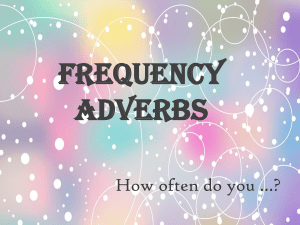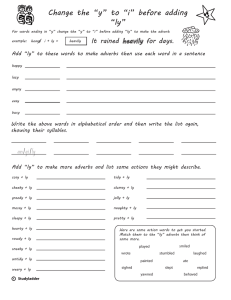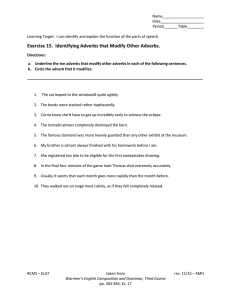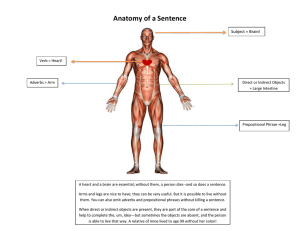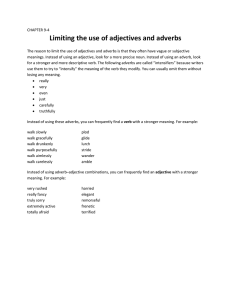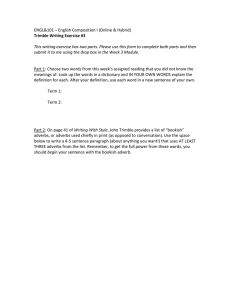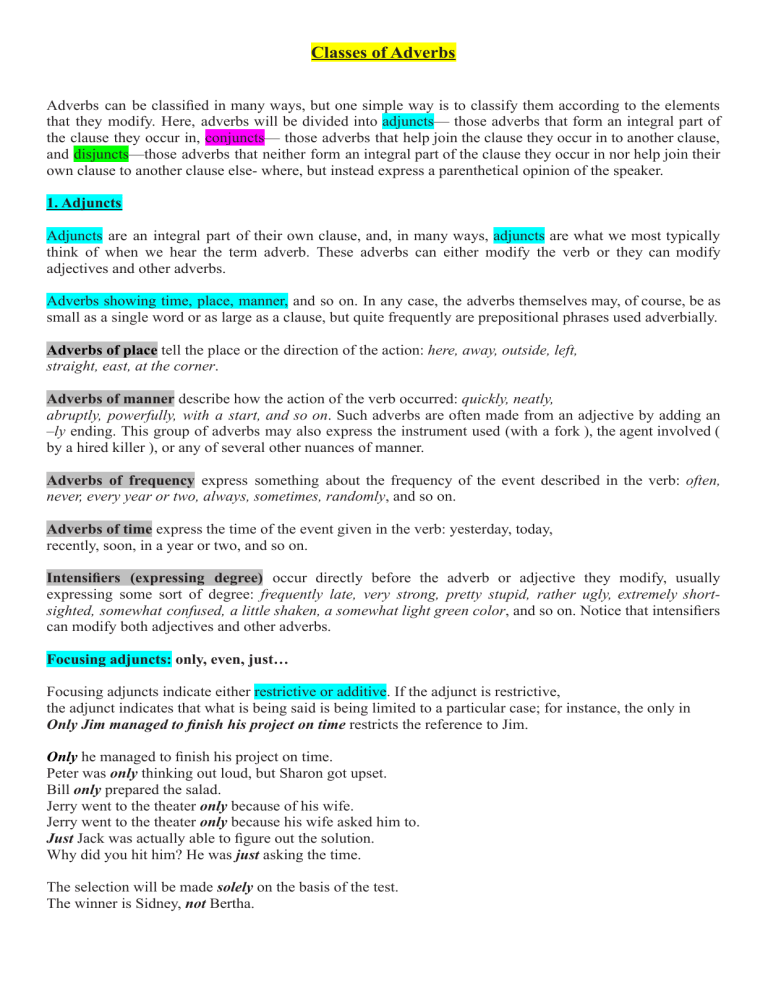
Classes of Adverbs Adverbs can be classified in many ways, but one simple way is to classify them according to the elements that they modify. Here, adverbs will be divided into adjuncts— those adverbs that form an integral part of the clause they occur in, conjuncts— those adverbs that help join the clause they occur in to another clause, and disjuncts—those adverbs that neither form an integral part of the clause they occur in nor help join their own clause to another clause else- where, but instead express a parenthetical opinion of the speaker. 1. Adjuncts Adjuncts are an integral part of their own clause, and, in many ways, adjuncts are what we most typically think of when we hear the term adverb. These adverbs can either modify the verb or they can modify adjectives and other adverbs. Adverbs showing time, place, manner, and so on. In any case, the adverbs themselves may, of course, be as small as a single word or as large as a clause, but quite frequently are prepositional phrases used adverbially. Adverbs of place tell the place or the direction of the action: here, away, outside, left, straight, east, at the corner. Adverbs of manner describe how the action of the verb occurred: quickly, neatly, abruptly, powerfully, with a start, and so on. Such adverbs are often made from an adjective by adding an –ly ending. This group of adverbs may also express the instrument used (with a fork ), the agent involved ( by a hired killer ), or any of several other nuances of manner. Adverbs of frequency express something about the frequency of the event described in the verb: often, never, every year or two, always, sometimes, randomly, and so on. Adverbs of time express the time of the event given in the verb: yesterday, today, recently, soon, in a year or two, and so on. Intensifiers (expressing degree) occur directly before the adverb or adjective they modify, usually expressing some sort of degree: frequently late, very strong, pretty stupid, rather ugly, extremely shortsighted, somewhat confused, a little shaken, a somewhat light green color, and so on. Notice that intensifiers can modify both adjectives and other adverbs. Focusing adjuncts: only, even, just… Focusing adjuncts indicate either restrictive or additive. If the adjunct is restrictive, the adjunct indicates that what is being said is being limited to a particular case; for instance, the only in Only Jim managed to finish his project on time restricts the reference to Jim. Only he managed to finish his project on time. Peter was only thinking out loud, but Sharon got upset. Bill only prepared the salad. Jerry went to the theater only because of his wife. Jerry went to the theater only because his wife asked him to. Just Jack was actually able to figure out the solution. Why did you hit him? He was just asking the time. The selection will be made solely on the basis of the test. The winner is Sidney, not Bertha. If the adjunct is additive, the adjunct indicates that what is being said is being extended to an additional case; for instance, the even in Even Jim managed to finish his project on time adds Jim to the group that finished their projects on time. Even Jim managed to finish his project on time. This week Bill even did the assigned readings. Ela, in particular, was unhappy with the constant delays. We did some work as well. Colonel Mustard, likewise , has taken the Fifth Subject-verb inversion When certain adverbs occur at the beginning of a sentence, the normal position of the subject and the verb are reversed. Seldom had he ever said anything nice. Never have so many taken so long to say so little. Scarcely had Jill entered the office, when trouble started. Usually these adverbs have a negative meaning. Another similar group that involves the reversal of the position of the subject and verb includes only, so …, and such a.... Only twice was he late in fourteen years of service. Such a brilliant woman was she that few dared oppose her. So thorough was her preparation that no problems arose. Yet another group involves putting an adverb of place at the front of a sentence and then reversing the normal order of subject and verb. Here comes the judge. Inside the small cave were four people huddled together. Among the guests were a Senator and two Congressmen. There sat Professor Samuels eating his lunch. This last pattern is used to introduce something new onto the scene. 2. Conjuncts Conjuncts are those adverbial words, phrases and clauses which have a cohesive function, connecting different sections of a text. We generally use them at or near the beginning of a sentence, so that they provide a link to the previous sentence or paragraph. They help the text to flow by giving continuity to earlier information for the reader. As with adjuncts, there are different ways of using conjuncts: addition – also, furthermore, moreover, in addition, what is more ● opposition – however, nevertheless, on the other hand ● reinforcing – besides, anyway, after all ● explaining – for example, in other words, that is to say ● listing – first(ly), first of all, next, finally ● indicating result – therefore, consequently, as a result ● indicating time – just then, meanwhile, later, in the meantime ● I came late. Therefore, I missed his introduction. He is being rude. Moreover, he isn't helping. He has lots of money. However, there's nothing he wants to buy. The train was late. Additionally, it was overcrowded and uncomfortable. 3. Disjuncts Disjuncts are adverbial words, phrases and clauses which enable the speaker or writer to express beliefs or opinions about what they are communicating. They signal the attitude of the speaker/writer. For example, obviously, unfortunately, personally, of course, in my opinion, which is certain, although this is clearly incorrect. .Hopefully, she will be waiting Personally, I don't believe he wrote to me Obviously, she lied
